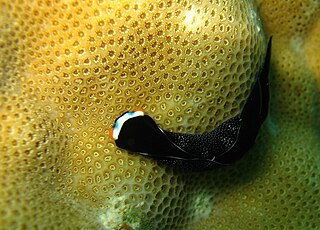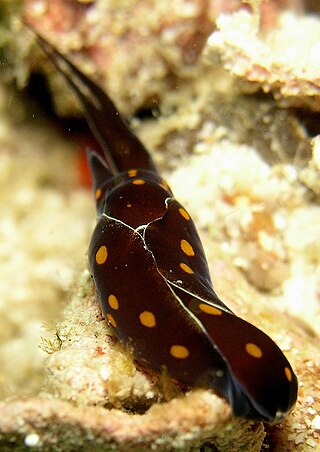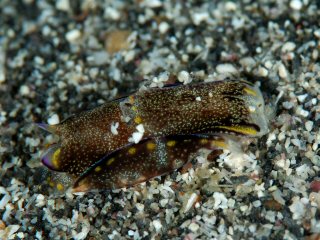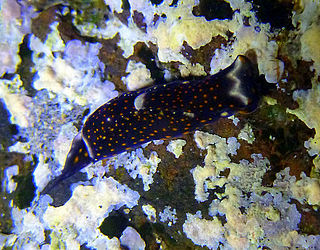
Sea slug is a common name for some marine invertebrates with varying levels of resemblance to terrestrial slugs. Most creatures known as sea slugs are gastropods, i.e. they are sea snails that, over evolutionary time, have either entirely lost their shells or have seemingly lost their shells due to having a significantly reduced or internal shell. The name "sea slug" is often applied to nudibranchs and a paraphyletic set of other marine gastropods without apparent shells.

The order Cephalaspidea, also known as the headshield slugs and bubble snails, is a major taxon of sea slugs and bubble snails, marine gastropod mollusks within the larger clade Euopisthobranchia. Bubble shells is another common name for these families of marine gastropods, some of which have thin bubble-like shells. This clade contains more than 600 species.

Navanax inermis, common name the California aglaja, is a large species of predatory sea slug, a marine opisthobranch gastropod mollusk in the family Aglajidae. Navanax is not a nudibranch, even though it somewhat resembles one; it belongs to a more ancient lineage of opisthobranchs called the cephalaspideans or head shield slugs and snails.

Aglajidae is a family of often colorful, medium-sized, sea slugs, marine opisthobranch gastropod mollusks. These are not nudibranchs; instead they are headshield slugs, in the clade Cephalaspidea.

Chelidonura varians is a species of small sea slug, a marine opisthobranch gastropod mollusc in the order Cephalaspidea, the headshield slugs.

Chelidonura hirundinina is a species of small and colorful aglajid sea slug, a shell-less opisthobranch gastropod mollusk in the family Aglajidae.

Mariaglaja inornata, also called the inornate headshield slug, is a species of sea slug or headshield slug, a marine opisthobranch gastropod mollusc in the family Aglajidae.

Chelidonura punctata is a species of sea slug, or "headshield slug", a marine opisthobranch gastropod mollusk in the family Aglajidae.

Philinopsis gigliolii is a species of small and colorful aglajid sea slug, a shell-less opisthobranch gastropod mollusk in the family Aglajidae.

Philiopsis is a genus of often colorful, medium-sized sea slugs, marine opisthobranch gastropod mollusks. These are not nudibranchs; instead they are headshield slugs, in the clade Cephalaspidea.

Melanochlamys is a genus of headshield slugs in the family Aglajidae. Despite the appearance of its species, this genus must not be confused with nudibranchs.

Chelidonura electra is a species of sea slug, a "headshield slug", a marine opisthobranch gastropod mollusk in the family Aglajidae. The species name comes from the daughter of Agamemnon, Electra, and the Greek goddess of the same name, meaning "shining", with reference to the brilliance of this slug.

Kaloplocamus peludo is a species of sea slug, a nudibranch, a shell-less marine gastropod mollusc in the family Polyceridae.

Biuve fulvipunctata, the white-speckled headshield slug, is a species of sea slug or headshield slug, a marine opisthobranch gastropod mollusc in the family Aglajidae. This species is widespread in the Indian and Pacific Oceans but has invaded the Mediterranean Sea since 1961, despite apparently being absent from the Red Sea until recorded there in the 21st century. It is the only species in the monotypic genus Biuve.

Tubulophilinopsis gardineri, the Gardiner’s philinopsis, or Gardiner's headshield slug is a species of sea slug, a shell-less opisthobranch gastropod mollusc in the family Aglajidae. It is native to the Indo-Pacific region.

Philinopsis capensis, the slipper slug, is a species of sea slug, a shell-less opisthobranch gastropod mollusc in the family Aglajidae.
Philinopsis depicta is a species of sea slug, an opisthobranch gastropod mollusc in the family Aglajidae. It is native to the Mediterranean Sea where it lives on the sandy seabed in shallow water. It is a predator.

Thuridilla vataae is a species of sacoglossan sea slug, a shell-less marine opisthobranch gastropod mollusc in the family Plakobranchidae. It is native to the tropical Indo-Pacific. It was first described by the French zoologist Jean Risbec in 1928; its specific name refers to the Bay of Anse Vata, just south of Nouméa, New Caledonia, where the type specimen was collected.

Thuridilla moebii is a species of sacoglossan sea slug, a shell-less marine opisthobranch gastropod mollusc in the family Plakobranchidae. It is found in shallow water in the tropical west and central Indo-Pacific region.
Aglaja tricolorata is a species of sea slug, an opisthobranch gastropod mollusc in the family Aglajidae. It is native to the Mediterranean Sea and the tropical eastern Atlantic Ocean where it lives in shallow water on the sandy seabed.


















